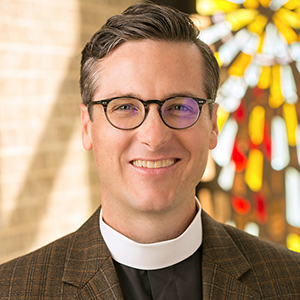
I’ve heard from more than a few of you that you’re somewhat confused by the new “expansive language” rites we’ve begun using for our worship. The confusion centers on what is perceived as inconsistency in the new rite. The stated purpose of the revisions is to remove gendered and patriarchal references for God, which led to the removal of almost all instances of “he/his/him,” along with many instances of the words “kingdom,” “Father,” and “Lord.” But why, many of you have asked, do all of those words still appear some of the time?
The reason is that the purpose of the revised rite is, as the nickname for it suggests, to expand our language for God. The goal is not to simply replace one set of words with another, but to grow our vocabulary so that we use a wider range of names and words to speak to and about God. Thus, while “kingdom” is replaced with “reign” in the opening acclamation, the language of kingdom to describe God’s dominion is Biblical and ancient, and thus it continues to be used elsewhere.
Same with referring to the first person of God as “Father.” As we’ll be reminded in the gospel this weekend when Jesus teaches his disciples to pray, it is to “our Father,” and a great many Christians down through the centuries have felt more intimately connected to God by praying to “our Father in heaven.” Yet, too often the church has been over-reliant on that metaphor, and not deployed other, similarly evocative language for God. Thus, the rite replaces some instances of the word “Father,” while leaving others.
And the same with “Lord.” I will admit that this is the hardest word for me to substitute, as I have long leaned on this idea in my heart and imagination. When I use the word Lord, it helps me see myself in submission to Jesus, who is to me more than friend or teacher or example (though he’s those things, too). He is my master and my Lord. He is in charge of my life. I am under his dominion and authority. But notice the word that often replaces “Lord” in the revised rite – “Savior” –is similarly powerful and evocative! Jesus is Savior, too, and by calling him Savior, as well as Lord, in the course of the Eucharist, our hearts and minds are stretched in holy ways to see him for all his significance and identity.
Oh, and you may have noticed I just used the word “him” to refer to Jesus, just as the revised rite continues to do, though far less frequently. The eternal Logos (“Word”; John 1) became incarnate by the Holy Spirit and the Virgin Mary and born a man. But while the Word became man, it is Jesus’ humanity, not his maleness, that is most essential. Thus, the rite replaces many of those gendered pronouns with the word “Christ.”
All language to describe God has potentially problematic shadow sides. No metaphor is able to work perfectly in all contexts or for all people. With these changes, the Episcopal Church seeks not to put a better box around our understanding of God, but to broaden our spiritual imaginations such that we understand how far beyond our language God is. I hope you’ll continue to find meaning and holiness in our liturgy, even with the changes, for it is at the root of who we are as a church.
See you this weekend.

